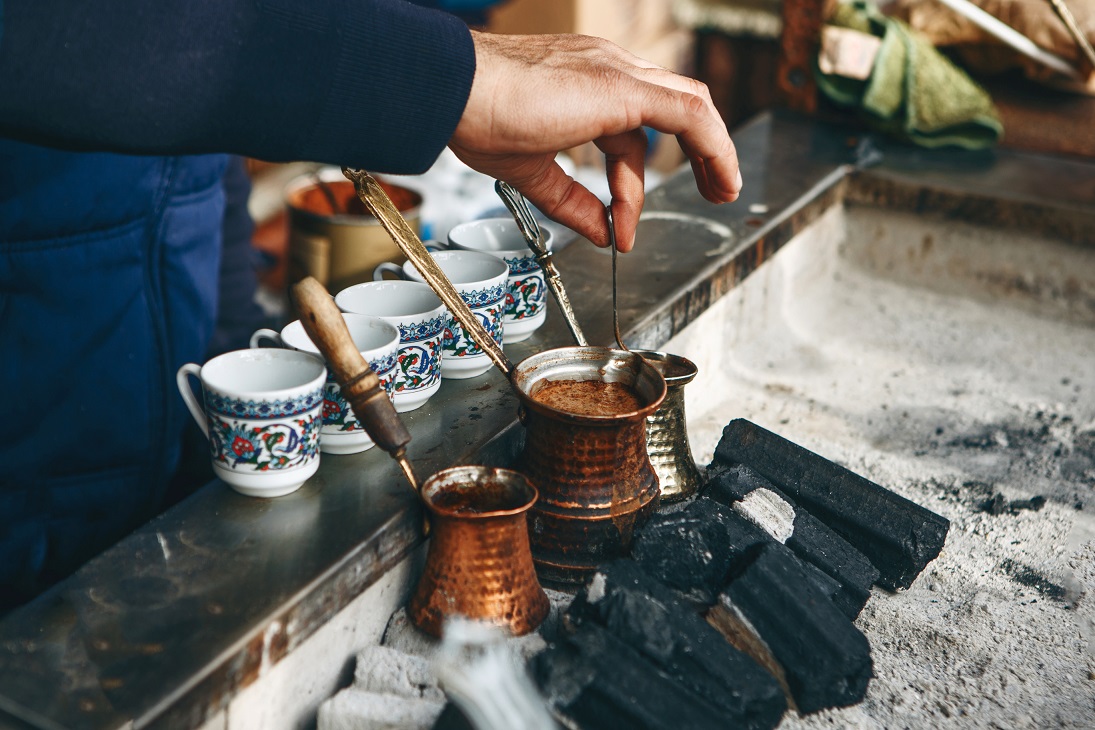
By Staff Middle Land
After its introduction to the Ottoman empire in the 16th century, Turkish coffee gradually took a central place in social rituals. No matter how many Western coffee chains pop up in Istanbul, Turkish coffee is still going strong, especially among the young.
By Fulya Ozerkan
Journalist in Istanbul, Türkiye
Large crowds pass by the colourful stalls in Eminonu as sellers’ voices fill the air in this old neighbourhood on the south bank of the Golden Horn. It’s easy to locate the Turkish coffee shop Kuru Kahveci Mehmet Efendi because of the long line that forms outside. Or you can simply follow the strong aroma that fills the air after you leave Istanbul’s iconic Grand Bazaar.
Among those queuing is Guldane Aktas, 50, who drinks two cups of Turkish coffee a day. The distinct scent of ground coffee beans boosts her mood and brings a smile to her face. “It’s worth the wait in the queue. The coffee is very fresh,” she says. “Whenever I stop over in Eminonu, I don’t leave before getting my pack of Turkish coffee.”
“Turkish coffee is strong but it doesn’t matter. We like its taste,” says Syrian refugee woman Safiye, waiting in the queue alongside her husband.
Cenk Girginol, author of Coffee: from the Soil to the Cup, describes Turkish coffee as a culture because it has never existed solely as a beverage. According to a famous Turkish proverb, a cup of coffee can create a friendship that lasts for 40 years. Turkish coffee culture and tradition was added to the UNESCO Representative List of the Intangible Cultural Heritage in 2013.
Salted coffee for the groom
In the past, Turkish coffee was an integral part of social life in neighbourhood coffee houses. In Anatolia it served as a means of resolving disputes. Whenever two men fell out in the village, they were served friendship coffee to open a dialogue and end their resentment.
Today it plays a major role in wedding rituals. When the groom’s family visits the bride’s house before the wedding, the bride is expected to prepare a perfect Turkish coffee. In the past, this was often the only opportunity for the future bride and groom to meet. If the bride was fond of the groom-to-be, she would prepare coffee with sugar, but if she didn’t like the candidate, she would put salt in his coffee instead. Today, paradoxically, some future brides serve salty coffee to the groom during this ritual to measure the extent of his love. If he likes the girl, he drinks the salty coffee instead of spitting it out.
“In Anatolia, whenever two persons fell out, a friendship coffee was served to end the dispute”
“Coffee has always been used as a pretext to initiate a conversation,” Cenk Girginol says. Coffee plays a major role in everyday life, whether it’s in the form of “morning coffee” (sabah kahvesi), “pleasure coffee” (keyif kahvesi) or “fatigue coffee” (yorgunluk kahvesi).
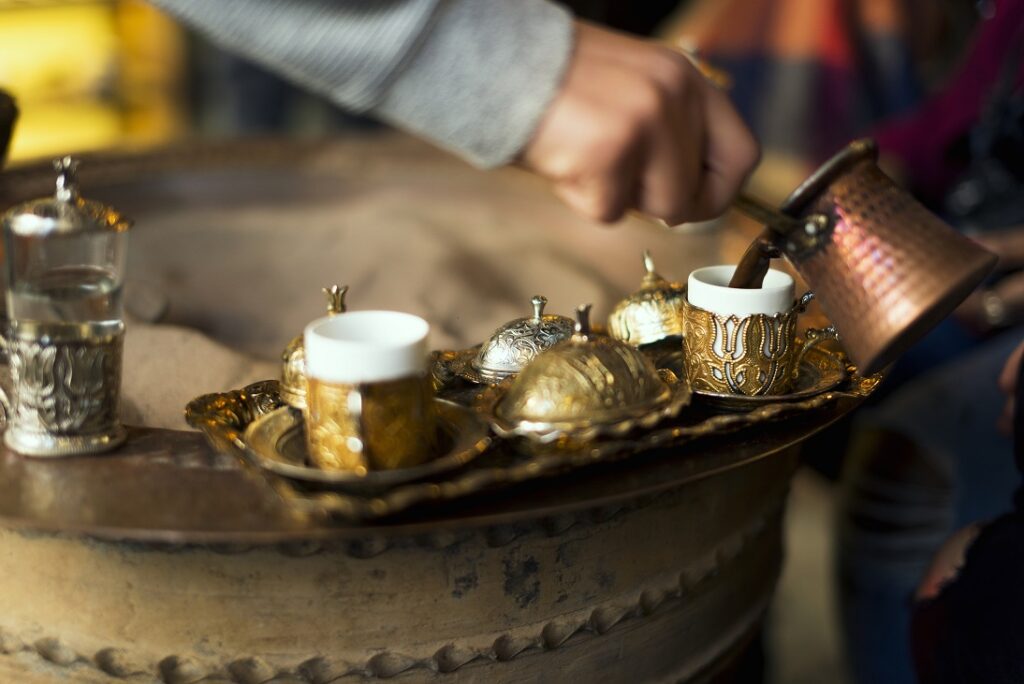
The preparation is quite a ceremony in itself. All you need is a small pot with a long handle called cezve and a small coffee cup called fincan with its saucer. As the coffee starts to boil, foam rises on top. This foam is the distinctive feature of a good Turkish coffee, which is served with a glass of water and accompanied by Turkish delight.
“There is also the ritual of reading coffee grounds,” Girginol adds. The grounds left in the empty cup are often used to tell a person’s fortune. Forecasting the future among friends or consulting professional fortune-tellers is a popular pastime. There are even apps, such as Faladdin, that provide comments within seconds after sending a picture of an empty cup.
Grinding and roasting
The history of Turkish coffee dates back to the 16th century and the reign of the Ottoman Sultan Suleiman the Magnificent. Legend tells us that an Ottoman governor who was posted in Yemen became fond of the coffee and introduced it to the palace’s cuisine.
“The first coffee house opened in Istanbul in 1554,” Girginol says. He explains that during the 1683 Siege of Vienna, the Ottoman troops abandoned coffee sacks after failing to capture the city, thus introducing coffee to Europe. “Its popularity has rapidly spread to other countries since then.”
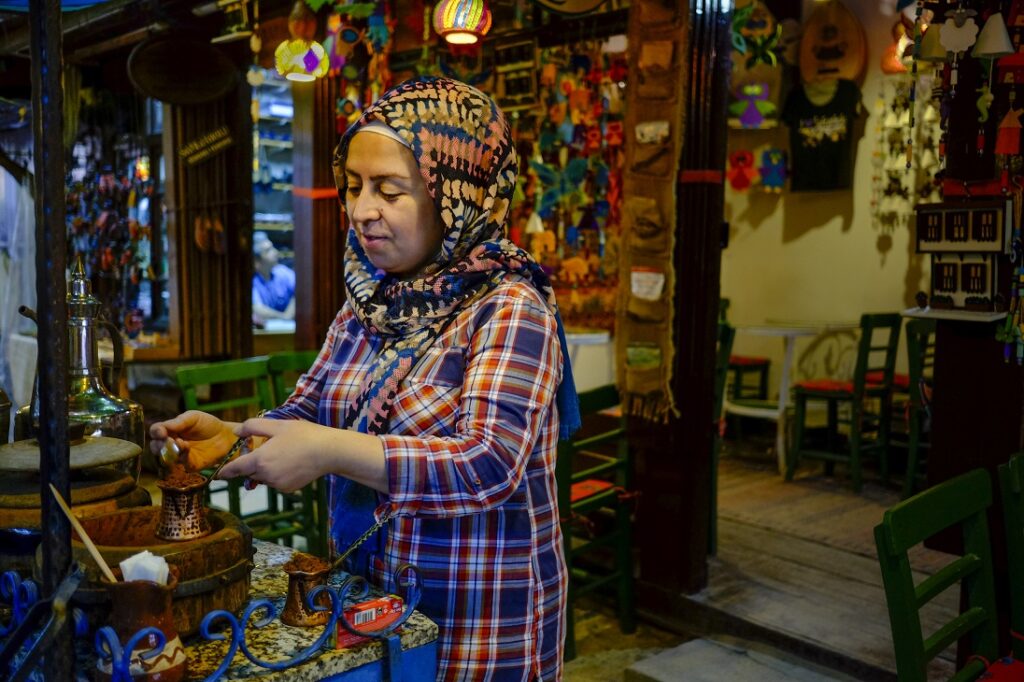
“When coffee beans arrived in the Ottoman lands, they were roasted, ground and cooked to turn into a unique taste. Today, we all enjoy drinking coffee thanks to the Turks who introduced a new brewing technique in the 16th century,” claims Gizem Salcigil White, a Turkish-American entrepreneur nicknamed “Turkish Coffee Lady”. “After five centuries, this ancient coffee pot cezve is still in use in Türkiye as well as many Balkan and Middle Eastern countries,” she adds.
White has been travelling the world with an award-winning Turkish Coffee Truck since 2012 to increase awareness of Turkish coffee culture in the United States and beyond.
The history of Turkish coffee dates back to the 16th century and the reign of the Ottoman Sultan Suleiman the Magnificent. Legend tells us that an Ottoman governor who was posted in Yemen became fond of the coffee and introduced it to the palace’s cuisine.
“The first coffee house opened in Istanbul in 1554,” Girginol says. He explains that during the 1683 Siege of Vienna, the Ottoman troops abandoned coffee sacks after failing to capture the city, thus introducing coffee to Europe. “Its popularity has rapidly spread to other countries since then.”
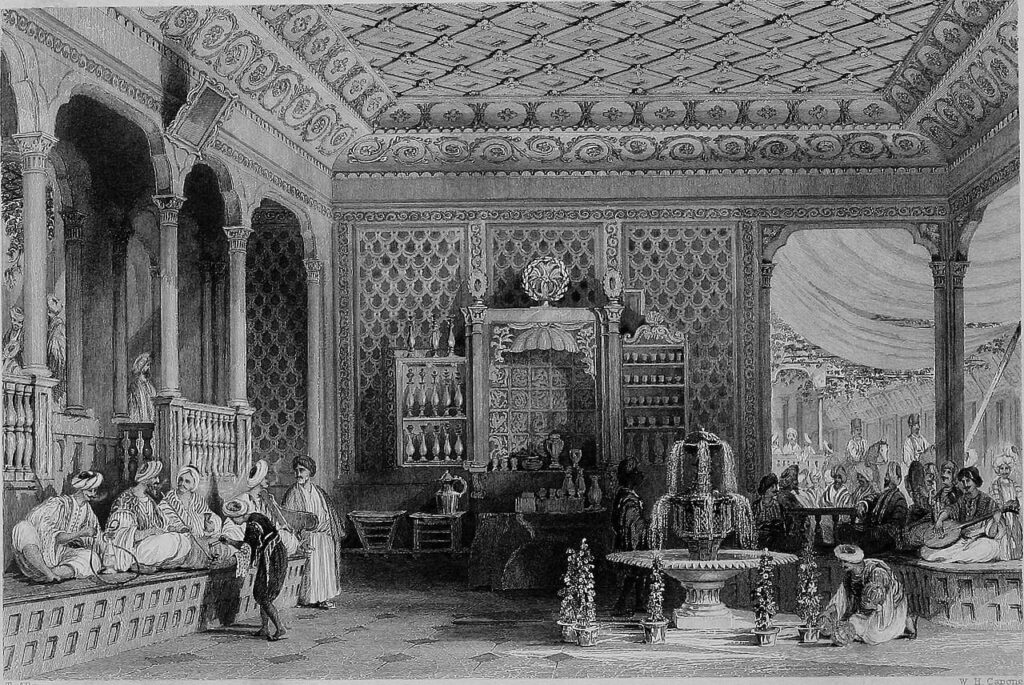
“When coffee beans arrived in the Ottoman lands, they were roasted, ground and cooked to turn into a unique taste. Today, we all enjoy drinking coffee thanks to the Turks who introduced a new brewing technique in the 16th century,” claims Gizem Salcigil White, a Turkish-American entrepreneur nicknamed “Turkish Coffee Lady”. “After five centuries, this ancient coffee pot cezve is still in use in Türkiye as well as many Balkan and Middle Eastern countries,” she adds.
White has been travelling the world with an award-winning Turkish Coffee Truck since 2012 to increase awareness of Turkish coffee culture in the United States and beyond.
“Turkish coffee’ does not mean coffee produced in Türkiye, but the method of making it: the roast level and grinding of the beans”
“Turkish coffee” does not mean coffee produced in Türkiye, according to Osman Serim, board member of the Turkish Coffee Culture and Research Association. According to him, “it is not the botanical type but the method of making it that counts: the degree of roasting – medium roast – and grinding”. In Turkish coffee, the beans are ground even thinner than in Italian espresso, Serim says. “This makes it possible to serve the coffee with the grounds. The grounds do not enter the mouth.”
Like everywhere else, Western coffee chains have expanded in Türkiye in recent years. But Cenk Girginol is positive that despite the popularity of foreign brands, the local coffee culture will prevail. Osman Serim agrees. “Turkish coffee is not in danger of extinction. On the contrary it is getting very popular, especially among young people.”
Original article: UNESCO


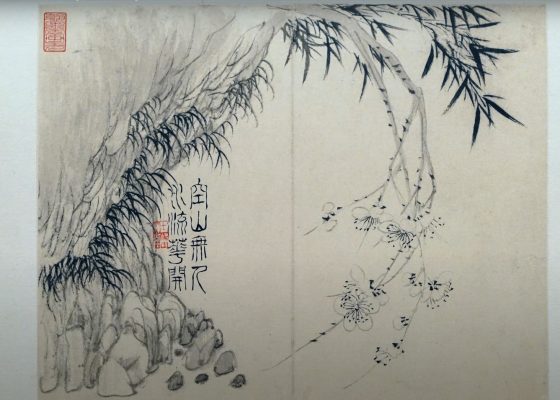









Cancel anytime


Using our website
You may use the The Middle Land website subject to the Terms and Conditions set out on this page. Visit this page regularly to check the latest Terms and Conditions. Access and use of this site constitutes your acceptance of the Terms and Conditions in-force at the time of use.
Intellectual property
Names, images and logos displayed on this site that identify The Middle Land are the intellectual property of New San Cai Inc. Copying any of this material is not permitted without prior written approval from the owner of the relevant intellectual property rights.
Requests for such approval should be directed to the competition committee.
Please provide details of your intended use of the relevant material and include your contact details including name, address, telephone number, fax number and email.
Linking policy
You do not have to ask permission to link directly to pages hosted on this website. However, we do not permit our pages to be loaded directly into frames on your website. Our pages must load into the user’s entire window.
The Middle Land is not responsible for the contents or reliability of any site to which it is hyperlinked and does not necessarily endorse the views expressed within them. Linking to or from this site should not be taken as endorsement of any kind. We cannot guarantee that these links will work all the time and have no control over the availability of the linked pages.
Submissions
All information, data, text, graphics or any other materials whatsoever uploaded or transmitted by you is your sole responsibility. This means that you are entirely responsible for all content you upload, post, email or otherwise transmit to the The Middle Land website.
Virus protection
We make every effort to check and test material at all stages of production. It is always recommended to run an anti-virus program on all material downloaded from the Internet. We cannot accept any responsibility for any loss, disruption or damage to your data or computer system, which may occur while using material derived from this website.
Disclaimer
The website is provided ‘as is’, without any representation or endorsement made, and without warranty of any kind whether express or implied.
Your use of any information or materials on this website is entirely at your own risk, for which we shall not be liable. It is your responsibility to ensure any products, services or information available through this website meet your specific requirements.
We do not warrant the operation of this site will be uninterrupted or error free, that defects will be corrected, or that this site or the server that makes it available are free of viruses or represent the full functionality, accuracy and reliability of the materials. In no event will we be liable for any loss or damage including, without limitation, loss of profits, indirect or consequential loss or damage, or any loss or damages whatsoever arising from the use, or loss of data, arising out of – or in connection with – the use of this website.
Last Updated: September 11, 2024
New San Cai Inc. (hereinafter “The Middle Land,” “we,” “us,” or “our”) owns and operates www.themiddleland.com, its affiliated websites and applications (our “Sites”), and provides related products, services, newsletters, and other offerings (together with the Sites, our “Services”) to art lovers and visitors around the world.
This Privacy Policy (the “Policy”) is intended to provide you with information on how we collect, use, and share your personal data. We process personal data from visitors of our Sites, users of our Services, readers or bloggers (collectively, “you” or “your”). Personal data is any information about you. This Policy also describes your choices regarding use, access, and correction of your personal information.
If after reading this Policy you have additional questions or would like further information, please email at middleland@protonmail.com.
PERSONAL DATA WE COLLECT AND HOW WE USE IT
We collect and process personal data only for lawful reasons, such as our legitimate business interests, your consent, or to fulfill our legal or contractual obligations.
Information You Provide to Us
Most of the information Join Talents collects is provided by you voluntarily while using our Services. We do not request highly sensitive data, such as health or medical information, racial or ethnic origin, political opinions, religious or philosophical beliefs, trade union membership, etc. and we ask that you refrain from sending us any such information.
Here are the types of personal data that you voluntarily provide to us:
As a registered users or customers, you may ask us to review or retrieve emails sent to your business. We will access these emails to provide these services for you.
We use the personal data you provide to us for the following business purposes:
Information Obtained from Third-Party Sources
We collect and publish biographical and other information about users, which we use to promote the articles and our bloggers who use our sites. If you provide personal information about others, or if others give us your information, we will only use that information for the specific reason for which it was provided.
Information We Collect by Automated Means
Log Files
The site uses your IP address to help diagnose server problems, and to administer our website. We use your IP addresses to analyze trends and gather broad demographic information for aggregate use.
Every time you access our Site, some data is temporarily stored and processed in a log file, such as your IP addresses, the browser types, the operating systems, the recalled page, or the date and time of the recall. This data is only evaluated for statistical purposes, such as to help us diagnose problems with our servers, to administer our sites, or to improve our Services.
Do Not Track
Your browser or device may include “Do Not Track” functionality. Our information collection and disclosure practices, and the choices that we provide to customers, will continue to operate as described in this Privacy Policy, whether or not a “Do Not Track” signal is received.
HOW WE SHARE YOUR INFORMATION
We may share your personal data with third parties only in the ways that are described in this Privacy Policy. We do not sell, rent, or lease your personal data to third parties, and We does not transfer your personal data to third parties for their direct marketing purposes.
We may share your personal data with third parties as follows:
There may be other instances where we share your personal data with third parties based on your consent.
HOW WE STORE AND SECURE YOUR INFORMATION
We retain your information for as long as your account is active or as needed to provide you Services. If you wish to cancel your account, please contact us middleland@protonmail.com. We will retain and use your personal data as necessary to comply with legal obligations, resolve disputes, and enforce our agreements.
All you and our data are stored in the server in the United States, we do not sales or transfer your personal data to the third party. All information you provide is stored on a secure server, and we generally accepted industry standards to protect the personal data we process both during transmission and once received.
YOUR RIGHTS/OPT OUT
You may correct, update, amend, delete/remove, or deactivate your account and personal data by making the change on your Blog on www.themiddleland.com or by emailing middleland@protonmail.com. We will respond to your request within a reasonable timeframe.
You may choose to stop receiving Join Talents newsletters or marketing emails at any time by following the unsubscribe instructions included in those communications, or you can email us at middleland@protonmail.com
LINKS TO OTHER WEBSITES
The Middle Land include links to other websites whose privacy practices may differ from that of ours. If you submit personal data to any of those sites, your information is governed by their privacy statements. We encourage you to carefully read the Privacy Policy of any website you visit.
NOTE TO PARENTS OR GUARDIANS
Our Services are not intended for use by children, and we do not knowingly or intentionally solicit data from or market to children under the age of 18. We reserve the right to delete the child’s information and the child’s registration on the Sites.
PRIVACY POLICY CHANGES
We may update this Privacy Policy to reflect changes to our personal data processing practices. If any material changes are made, we will notify you on the Sites prior to the change becoming effective. You are encouraged to periodically review this Policy.
HOW TO CONTACT US
If you have any questions about our Privacy Policy, please email middleland@protonmail.com
The Michelin brothers created the guide, which included information like maps, car mechanics listings, hotels and petrol stations across France to spur demand.
The guide began to award stars to fine dining restaurants in 1926.
At first, they offered just one star, the concept was expanded in 1931 to include one, two and three stars. One star establishments represent a “very good restaurant in its category”. Two honour “excellent cooking, worth a detour” and three reward “exceptional cuisine, worth a
Thank you for your participation,
please Log in or Sign up to Vote

123Sign in to your account